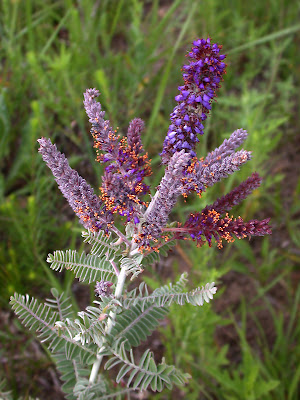Description: This native perennial plant is 1-3' tall, producing occasional side branches. Lead Plant is usually semi-erect; in partially shaded situations, it will sprawl along the ground in the direction of greater lighter. With age, it becomes increasing woody, assuming that growth and development are not disrupted by occasional fires or browsing from animals. The young stems are light green and covered with white hairs. The compound leaves are whitish to greyish green, depending on the intensity of sunlight reaching the plant. Sometimes fine hairs cover the plant to the extent that it appears to be heavily dusted with white lead, hence its name. The compound leaves are bipinnate, 4-12" long, and may have up to 50 small leaflets, each about ½" long and ¼" wide. The small flowers occur along pubescent spikes, about 2-6" long, at the ends of major branches. These flowers range in color from light to dark purple. Each flower has a single upper petal, which is tubular at first, but later unfolds horizontally to protect the reproductive parts. There are also 8 exerted reddish stamens with bright yellow anthers that are quite conspicuous. There is little or no floral scent. The blooming period occurs from early to mid-summer and lasts about 3 weeks. The central root occasionally branches, and can extend 15 ft. or more into the soil.
Cultivation: The preference is full sun and average to dry soil. Lead Plant is not particular about soil type, and will flourish in loamy, sandy, gravelly, or clay soil. It adds nitrogen to the soil. Partial sun is tolerated, but it will flower less abundantly and have a tendency to sprawl. Leadplant is easy to grow, but slow to develop – flowers may not appear for at least 3 years. A wire fence or cage may be necessary to protect young plants from rabbits and other herbivores.
The flowers of Leadplant attract long-tongued bees, short-tongued bees, and wasps primarily
Mammalian herbivores, such as deer, rabbits, and livestock, are very fond of this plant. It is high in protein and quite palatable. This can make Leadplant difficult to establish in areas where these animals are abundant.
Information was found here
Photo was found here

No comments:
Post a Comment